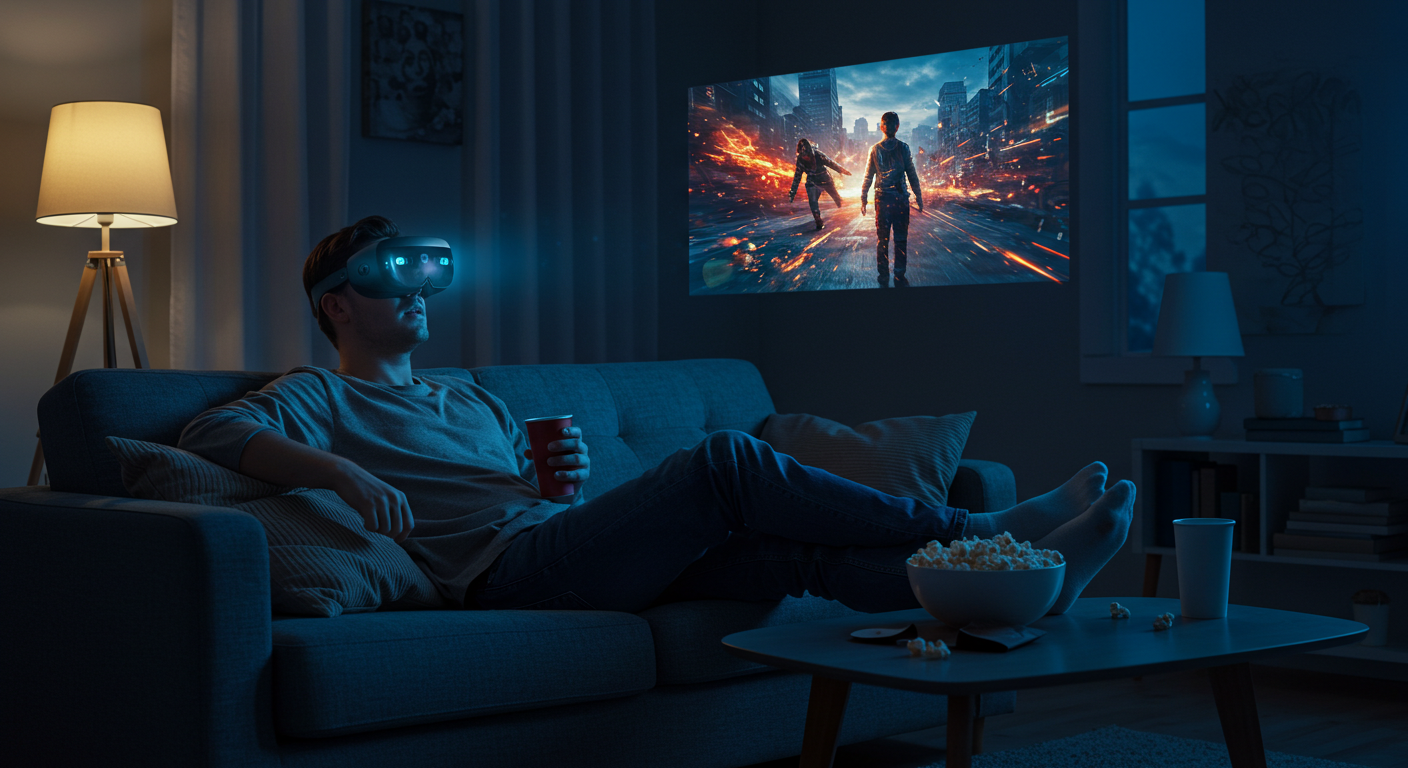An ar glasses buying guide is essential as augmented reality (AR) eyewear rapidly evolves. From immersive gaming to streamlined professional applications, AR glasses offer exciting possibilities. But with diverse features and price points, selecting the right pair can be daunting. This guide helps you navigate the options and choose AR glasses tailored to your unique needs.
Understanding AR Glass Technology & Use Cases
Augmented reality (AR) glasses are rapidly evolving, promising to blend digital information seamlessly with the physical world. Unlike virtual reality (VR) which creates a completely immersive digital environment, AR glasses overlay digital content onto your view of reality. This chapter will delve into the technology powering these devices, explore their diverse applications, and outline the current limitations hindering widespread adoption. This is a crucial step in your journey with this ar glasses buying guide.
Display Technologies: A Clearer View
The core of any AR experience is the display technology. Several approaches are currently used, each with its strengths and weaknesses. Waveguide technology, favored by XREAL and increasingly by others, uses a transparent lens with a holographic grating to project images. This offers a wide field of view (FOV) and good clarity, but can sometimes struggle with brightness in direct sunlight. Birdbath optics, employed in devices like the Microsoft HoloLens 2, uses a combination of mirrors and lenses. It provides excellent image quality and brightness but typically results in a narrower FOV and a more noticeable ‘tunnel vision’ effect. Finally, holographic displays aim to create true 3D images floating in space, but are still in early stages of development and face challenges with image fidelity and cost.
Caption: Comparison of typical field of view ranges for different AR display technologies.
Core Components: The Engine Behind the Magic
Beyond the display, AR glasses rely on a complex interplay of hardware. Powerful processors, often mobile chipsets like those from Qualcomm, are essential for handling the computationally intensive tasks of tracking, rendering, and object recognition. Sensors are equally critical. Cameras capture the surrounding environment, enabling spatial mapping and object detection. Inertial Measurement Units (IMUs) track head movements for accurate positioning of virtual objects. Depth sensors, like time-of-flight (ToF) sensors, provide detailed 3D information about the environment. Finally, connectivity options – Wi-Fi, Bluetooth, and increasingly 5G – allow for data streaming, remote collaboration, and access to cloud-based AR applications.
AR Use Cases: From Gaming to Industry
The potential applications of AR glasses are vast and span numerous sectors.

Gaming & Entertainment
AR gaming offers immersive experiences that blend virtual worlds with your physical surroundings. Imagine battling dragons in your living room or exploring ancient ruins in your backyard. AR content streaming allows for interactive movie nights and virtual concerts. Virtual events, enhanced with AR elements, can provide a more engaging and personalized experience.
Enterprise & Industrial Applications
This is where AR is currently making the biggest impact. Remote assistance allows experts to guide technicians through complex repairs in real-time, using AR annotations overlaid on their view. Training becomes more effective with interactive AR simulations. Maintenance is streamlined with AR-guided procedures. In logistics, AR can optimize warehouse operations and improve picking accuracy.
Everyday Productivity & Lifestyle
AR glasses can enhance daily life in numerous ways. Navigation becomes more intuitive with AR directions overlaid on the real world. Hands-free information access allows you to check notifications, read recipes, or control smart home devices without lifting a finger. AR-powered communication tools can enable more engaging video calls and collaborative workspaces.
Future Trends
Looking ahead to 2025 and beyond, we can expect to see AR glasses become more integrated into our lives. Emerging applications include AR-powered healthcare diagnostics, personalized shopping experiences, and advanced educational tools. The market is projected to grow significantly as the technology matures and becomes more affordable.
AR, VR, and MR: Defining the XR Landscape
AR glasses exist within the broader realm of Extended Reality (XR), which encompasses VR, AR, and Mixed Reality (MR). Virtual Reality (VR) creates a completely immersive digital environment, blocking out the physical world. Augmented Reality (AR) overlays digital content onto the real world, as discussed. Mixed Reality (MR) blends elements of both, allowing digital objects to interact with the physical environment. Devices like the Microsoft HoloLens 2 often fall into the MR category, as they can map the environment and allow virtual objects to realistically interact with it.
| Feature | AR | VR | MR |
|---|---|---|---|
| Environment | Real World + Digital Overlay | Completely Digital | Real World + Interactive Digital |
| Immersion | Partial | Full | High |
| Interaction | Limited | Limited | Significant |
Current Limitations & Challenges
Despite the exciting potential, AR glasses face several hurdles. Battery life remains a significant concern, with most devices offering only a few hours of use. Social acceptance is another challenge, as wearing bulky glasses in public can feel awkward. Furthermore, the cost of high-end AR glasses is still prohibitive for many consumers. As you continue your ar glasses buying guide research, keep these limitations in mind.
PROS
- Hands-free access to information
- Immersive entertainment experiences
- Increased productivity in industrial settings
- Potential for transformative applications
CONS
- Limited battery life
- High cost
- Social acceptance concerns
- Field of view limitations
Key Features to Evaluate
Embarking on an ar glasses buying guide requires careful consideration of several key features. While the allure of augmented reality is strong, the user experience hinges on how well these underlying components perform. From the clarity of the display to the comfort of the fit, making the right choices will determine whether your AR glasses are a revolutionary tool or a costly novelty.
Display Quality: Seeing is Believing
The display is arguably the most critical aspect of any AR glasses. Resolution dictates image sharpness, measured in pixels per degree (PPD). Higher PPD equates to a more detailed and realistic augmented view. Field of View (FOV) determines how much of your vision is covered by the AR content. A wider FOV creates a more immersive experience, minimizing the feeling of looking through goggles. Brightness and contrast are also vital; insufficient brightness makes the AR imagery difficult to see in well-lit environments, and poor contrast washes out details.
Caption: Comparison of Field of View across popular AR glasses models (2025).
Waveguide technology, currently the leading display method, projects images onto the lenses using a series of microscopic gratings. This provides a transparent and comfortable viewing experience. Future advancements promise even thinner waveguides, wider FOVs, and higher resolutions. Micro-OLED and Micro-LED technologies are also on the horizon, potentially offering superior brightness and color accuracy. The success of this ar glasses buying guide relies on understanding these emerging technologies.
Comfort & Ergonomics: Wearability Matters
AR glasses are only useful if you can comfortably wear them for extended periods. Weight distribution is crucial; a front-heavy design can cause neck strain. Adjustable components like nose pads and headbands are essential for a secure and personalized fit. Different frame designs cater to various face shapes and sizes. Consider whether the glasses are designed to be worn with regular eyeglasses if you require vision correction.
PROS
- Adjustable nose pads for customized fit.
- Lightweight designs minimize strain during prolonged use.
- Variety of frame styles to suit different preferences.
CONS
- Bulky designs can look conspicuous.
- Poor weight distribution leads to discomfort.
- Limited size options may not fit all users.
Look for materials that are skin-friendly and breathable, especially if you plan to wear the glasses during physical activity. A well-balanced and ergonomic design significantly contributes to long-term wearability.
Software & Compatibility: The Ecosystem
The operating system powering the AR glasses dictates the available apps, features, and overall user experience. Many glasses run on Android, providing access to a vast app library. However, some manufacturers opt for custom operating systems, often tailored to specific enterprise applications. App ecosystem depth is critical; a limited selection of apps diminishes the glasses’ versatility. Crucially, consider compatibility with your smartphone and other devices – seamless integration enhances usability.
Sensors & Tracking: Awareness of Space
Accurate tracking is fundamental to a compelling AR experience. Cameras capture the surrounding environment, enabling the glasses to understand their position in space. Inertial Measurement Units (IMUs) track movement and orientation. Depth sensors provide information about the distance to objects, allowing for realistic occlusion (where virtual objects appear to be hidden behind real-world objects). The combination of these sensors creates a stable and immersive augmented reality overlay.
Battery Life & Power Management: Staying Powered Up

Battery life remains a significant limitation for AR glasses. Typical battery life ranges from 2 to 4 hours, depending on usage and specific model. Look for glasses with hot-swappable batteries or external power options for extended use. Strategies for extending battery life include reducing brightness, disabling unnecessary features, and optimizing app usage.
Connectivity: Staying Connected
Wi-Fi is essential for downloading apps and streaming content. Bluetooth enables connectivity with smartphones, headphones, and other accessories. Emerging models are beginning to incorporate 5G support, enabling faster data transfer and more responsive AR experiences, particularly in mobile applications.
| Feature | Magic Leap 2 | XREAL Air |
|---|---|---|
| Resolution | 2.3M pixels per eye | 1.02M pixels per eye |
| Field of View | 52 degrees | 45 degrees |
| Battery Life | 3.5 hours | 4 hours |
With a comprehensive understanding of these features, fueled by this ar glasses buying guide, you’ll be well-equipped to navigate the rapidly evolving world of augmented reality eyewear and find the perfect pair to meet your needs.
Budget, Brands & Future-Proofing Your Investment
Choosing the right ar glasses buying guide involves more than just technical specifications. A significant part of the decision-making process revolves around your budget, the brands available, and how well your investment will hold up over time. The AR landscape is evolving rapidly, so careful consideration is crucial.
Price Ranges: What You Get for Your Money (2025)
AR glasses currently span a wide price range. Here’s a breakdown of what you can expect at different price points:
- Entry-Level ($300 – $700): These glasses typically focus on tethered experiences, meaning they connect to a smartphone or computer for processing power. Expect basic augmented reality features, limited tracking capabilities, and a focus on media consumption or simple productivity tasks. XREAL Air falls into this category.
- Mid-Range ($700 – $1500): This segment offers a blend of tethered and standalone capabilities. You’ll find improved display quality, more robust tracking, and a wider range of applications. Vuzix Blade and some configurations of Nreal/XREAL devices reside here.
- High-End ($1500 – $3500+): These are typically standalone devices with powerful processors, advanced sensors, and sophisticated tracking systems. They’re geared towards professional applications, complex AR experiences, and developers. Magic Leap 2 and Microsoft HoloLens 2 dominate this space.
Caption: Average price ranges for AR glasses in 2025.
Leading Brands: A Quick Overview
Several key players are shaping the AR glasses market:
- Magic Leap: Known for its advanced waveguide technology and focus on enterprise solutions. Strengths include high-quality visuals and robust tracking. Weaknesses include a high price point and limited consumer applications.
- Microsoft: HoloLens 2 is a powerhouse in the enterprise AR space, offering excellent tracking and integration with Microsoft’s ecosystem. It’s expensive and bulky, making it less suitable for everyday consumer use.
- Vuzix: Offers a range of AR glasses, from consumer-focused models to ruggedized enterprise devices. Strengths include affordability and versatility. Weaknesses can include lower display quality compared to Magic Leap or Microsoft.
- Nreal/XREAL: Pioneered lightweight, stylish AR glasses focused on media consumption and productivity. Strengths include affordability and comfort. Weaknesses include reliance on tethering to a smartphone or computer for processing power.
- Emerging Players: Companies like Rokid and Disguise are gaining traction with innovative designs and competitive pricing.
PROS
- Diverse range of brands and price points.
- Rapid innovation in display and tracking technologies.
- Growing ecosystem of AR applications.
CONS
- High cost of entry for high-end devices.
- Limited battery life.
- Software ecosystem still developing.
Warranty & Support: Protecting Your Investment
A comprehensive warranty is essential. Check the manufacturer’s warranty terms carefully, paying attention to coverage duration and what’s included. Good customer support is equally important. Look for brands that offer responsive technical assistance and readily available repair services. Extended warranties can provide peace of mind, but weigh the cost against the potential benefits.
Future-Proofing: Planning for the Long Term
AR technology is evolving at a breakneck pace. To future-proof your investment, consider these factors:
- Software Updates: Choose glasses with a commitment to regular software updates. These updates can improve performance, add new features, and address security vulnerabilities.
- Compatibility: Ensure the glasses are compatible with current and emerging AR platforms and applications.
- Hardware Upgradability: While full hardware upgrades are rare, some glasses may offer modular components that can be replaced or upgraded.
Hidden Costs: Beyond the Purchase Price
Don’t forget to factor in potential ancillary expenses. Some AR glasses require additional accessories, such as controllers or external tracking systems. Subscription fees may be required for access to certain software or content. Consider the cost of replacement parts, such as nose pads or cables.
Resale Value & Long-Term Ownership
AR glasses, like other tech gadgets, depreciate over time. Resale value will depend on the brand, model, condition, and the pace of technological advancements. Expect a significant drop in value within the first year. Long-term ownership costs include potential repairs, battery replacements, and software subscription fees.
Before making a purchase, consult reliable reviews from tech publications and user forums. Look for hands-on demonstrations and comparisons to get a feel for the different options available. Websites like UploadVR, Road to VR, and ARPost offer comprehensive coverage of the AR/VR space. This ar glasses buying guide aims to equip you with the knowledge to make an informed decision.
| Feature | Magic Leap 2 | XREAL Air |
|---|---|---|
| Price | $3299 | $379 |
| Standalone | Yes | No (Tethered) |
| Tracking | Advanced Spatial Tracking | Basic 6DoF |
Selecting the right AR glasses requires careful consideration of your use cases, budget, and desired features. This ar glasses buying guide has highlighted the key factors—display quality, comfort, and software compatibility—to help you make an informed decision. As the technology matures in 2025 and beyond, exploring demos and reading reviews will be vital.





